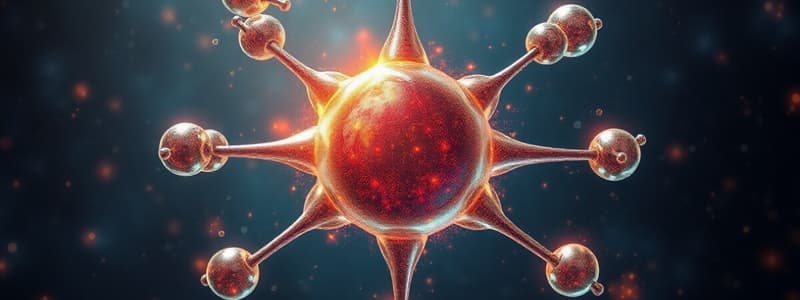Podcast
Questions and Answers
What does effective nuclear charge primarily affect in atomic properties?
What does effective nuclear charge primarily affect in atomic properties?
- Chemical reactivity of metals
- Ionization energy and electron affinity (correct)
- The boiling point of liquids
- The color of substances
Which type of bonding involves the sharing of electron pairs between atoms?
Which type of bonding involves the sharing of electron pairs between atoms?
- Covalent bonding (correct)
- Ionic bonding
- Metallic bonding
- Hydrogen bonding
Which of the following ionic compounds has the correct chemical formula given its constituent ions?
Which of the following ionic compounds has the correct chemical formula given its constituent ions?
- CaO for calcium and oxide ions
- Fe2O3 for iron(III) and oxide ions (correct)
- NaCl for sodium and chloride ions
- K2SO4 for potassium and sulfate ions
In Lewis structures, what does the octet rule state regarding atoms?
In Lewis structures, what does the octet rule state regarding atoms?
What does VSEPR theory help to determine regarding molecules?
What does VSEPR theory help to determine regarding molecules?
In the context of coordination compounds, what does the coordination number refer to?
In the context of coordination compounds, what does the coordination number refer to?
What characteristic of a molecule determines whether it is polar or nonpolar?
What characteristic of a molecule determines whether it is polar or nonpolar?
How do molecular orbitals form?
How do molecular orbitals form?
Flashcards are hidden until you start studying
Study Notes
Atomic Properties
- Atomic size: the size of an atom, determined by the distance between the nucleus and outermost electron shell.
- Ionization energy: the energy required to remove an electron from an atom in its gaseous state.
- Electron affinity: the change in energy when an electron is added to a neutral atom in its gaseous state.
- Effective nuclear charge: the net positive charge experienced by an electron in an atom, calculated as the difference between the number of protons in the nucleus and the number of core electrons.
Chemical Bonding
- Chemical bonds are the attractive forces that hold atoms together in molecules and ions.
- Ionic bonding occurs between metals and nonmetals when one atom gives up an electron to another atom, forming oppositely charged ions that are attracted to each other.
- Covalent bonding occurs between nonmetals when atoms share electrons to achieve a stable electronic configuration.
- Lewis symbols use dots to represent valence electrons, and arrow pushing illustrates electron movement during bond formation.
Lewis Structures and Resonance
- The octet rule states that atoms tend to gain, lose, or share electrons in order to achieve a stable configuration with eight valence electrons.
- Exceptions to the octet rule occur with elements like boron, beryllium, and elements in the third period and beyond.
- Resonance structures are multiple valid Lewis structures that represent the delocalization of electrons in a molecule.
- Formal charges help to determine the most stable resonance structure, and are calculated by subtracting the number of lone pair electrons and half the number of bonding electrons from the number of valence electrons of a free atom.
Ionic Compounds and Formulas
- The formula of an ionic compound is determined by the charges of the cation and anion.
- The overall charge of an ionic compound must be neutral.
- Common polyatomic ions should be memorized, including ammonium, cyanide, and acetate.
Bond Angles and Electron Geometry
- Bond angles refer to the angles between adjacent bonds in a molecule.
- Electron geometry describes the arrangement of electron pairs around a central atom.
- VSEPR theory predicts the shape of a molecule based on the repulsion between electron pairs.
- Molecular geometry refers to the arrangement of atoms in a molecule.
Molecular Orbitals
- Molecular orbitals are formed by the combination of atomic orbitals.
- The overlap of atomic orbitals can lead to constructive or destructive interference.
- Constructive interference leads to bonding orbitals, which are lower in energy than the atomic orbitals from which they are formed.
- Destructive interference leads to antibonding orbitals, which are higher in energy than the atomic orbitals from which they are formed.
- Molecular orbital diagrams can be used to predict the bond order and magnetic properties of diatomic molecules.
Acids and Bases
- Lewis acids are electron pair acceptors.
- Lewis bases are electron pair donors.
Coordination Compounds
- A coordination compound is a compound containing a metal ion bonded to one or more ligands, which are neutral molecules or anions containing a lone pair of electrons.
- The coordination number of a metal is the number of ligands attached to it.
- Crystal field theory helps to understand the electronic structure of coordination compounds.
Periodic Trends
- The effective nuclear charge is a key factor in understanding periodic trends.
- Effective nuclear charge increases across a period, leading to smaller atomic radii, higher ionization energies, and higher electron affinities.
- Effective nuclear charge decreases down a group, leading to larger atomic radii, lower ionization energies, and lower electron affinities.
Studying That Suits You
Use AI to generate personalized quizzes and flashcards to suit your learning preferences.



